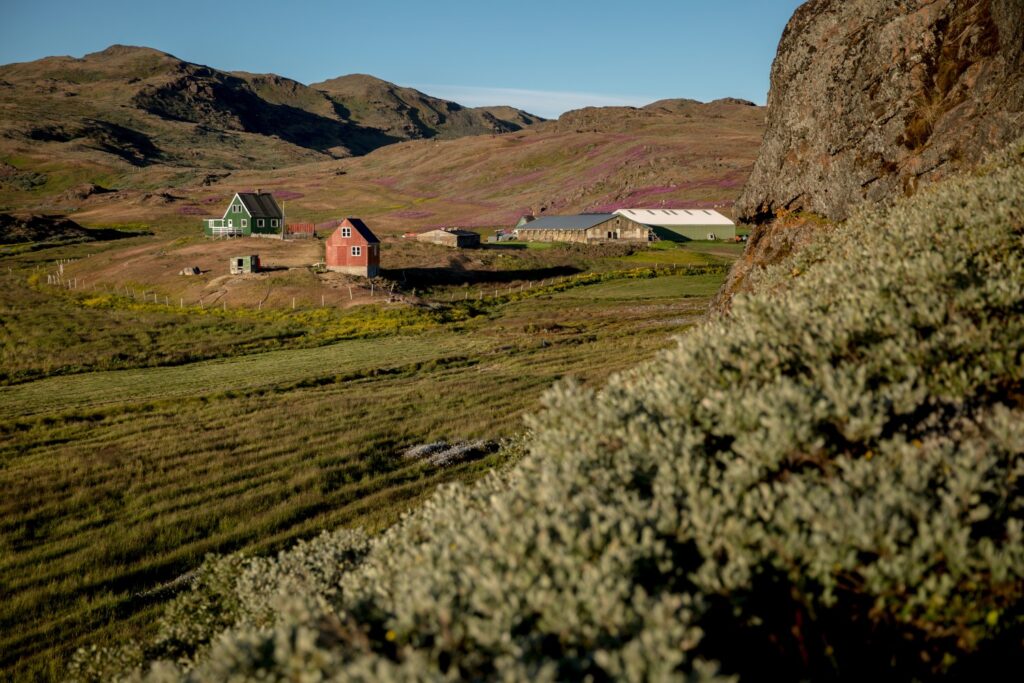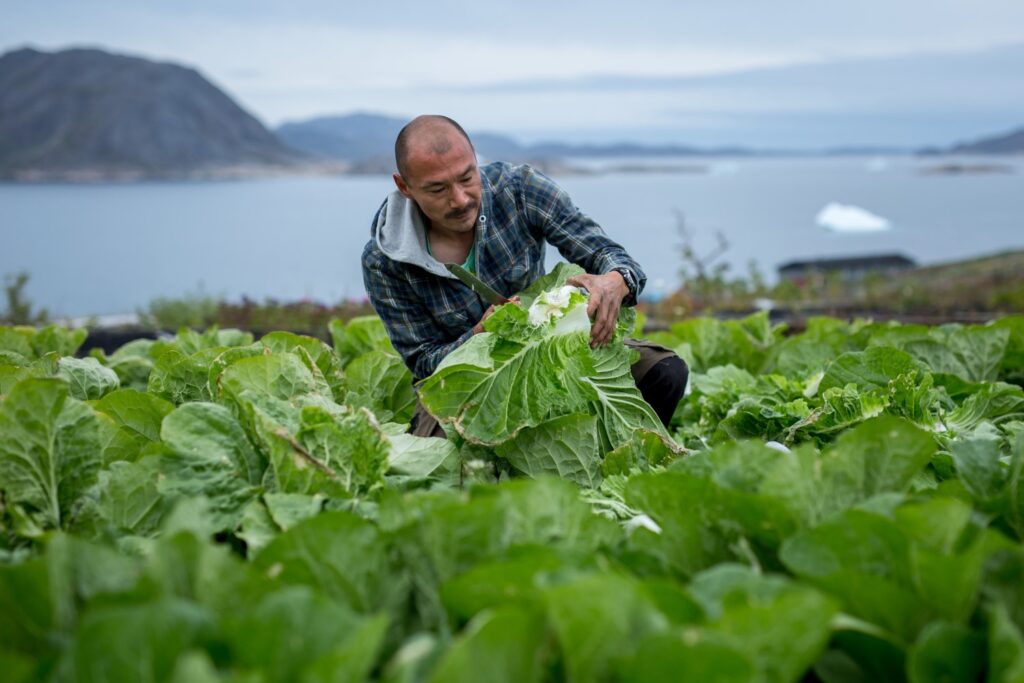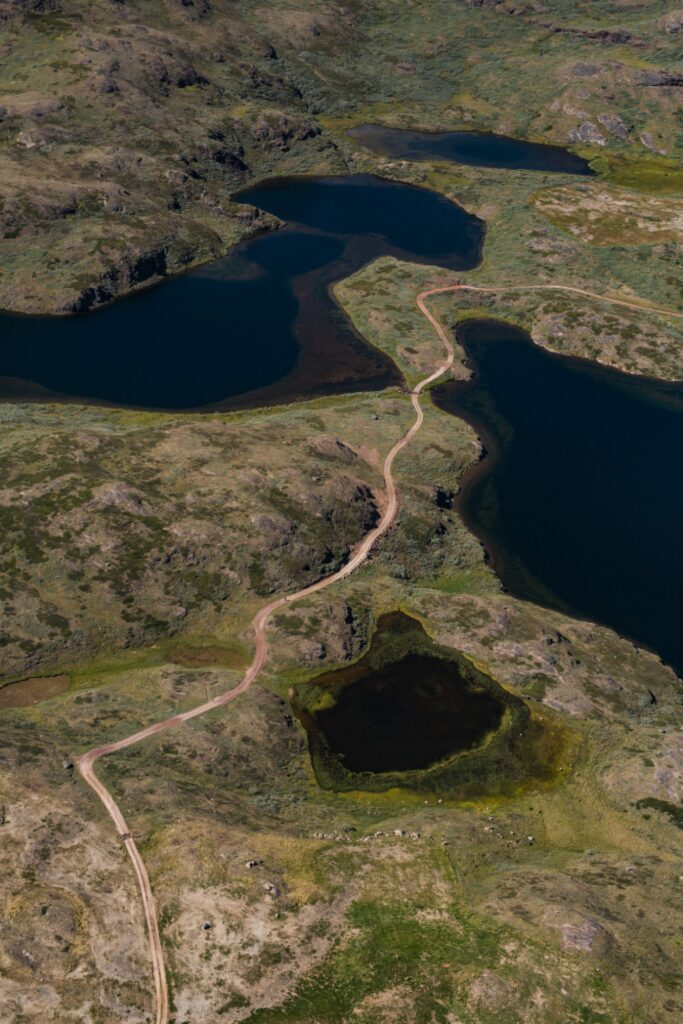
MADS PIHL, VISIT GREENLAND, 2015
The first known farms with livestock in Greenland are attributed to the Norse who settled around the year 985, after Erik the Red had visited and named the country. In more recent times, the first full-time farm was founded in 1924 in the settlement of Qassiarsuk, associated with the original farm of Erik the Red.
Livestock farming was already an additional livelihood in the settlement of Igaliku from 1783, where dairy cattle and goats grazed in the place where the ruins of Garðar, the diocese of the Norse, are located. Livestock farming with cattle and goats thus gradually became widespread in South Greenland up through the 19th century.
Agriculture and sheep farming, with few exceptions, are concentrated in South Greenland, where the subarctic climate deep within the fjords is sufficiently warm and winter is generally milder and shorter than farther north.

MADS PIHL, VISIT GREENLAND, 2015
The predominant part of Greenland agriculture is directly linked to sheep farming. The sheep graze out throughout the summer, and the fields are used for growing winter fodder, which is supplemented by imported concentrates.

ANINGAAQ R. CARLSEN/VISIT GREENLAND, 2018
The number of farms has gone from 54 in 2005 to 38 in 2019, while the number of large farms with more than 500 ewes has remained stable at 14‑18 farms over the same period. Since the turn of the millennium, sheep farming has evolved into intensive production from small to larger farms. The average size of a farm is 28.5 ha (2015) and most of the country’s farms, about 68 %, are found in the Narsaq district (2015). Farms are mostly run by individual families.
Life as a sheep farmer in Greenland is very special, not only because of the Sub-and Low-Arctic climate, but because most sheep farmers are cut off even more than the residents of the towns and settlements from the outside world, from infrastructure, public and private services, cultural offerings and something as obvious as schooling for their children. They have to manage most of it themselves. As well as raising sheep and growing crops, sheep farmers solve tasks that others would ask a carpenter, electrician, plumber or IT expert to do. And then they often teach their children themselves. It is not without reason that the sheep farmers’ children have a reputation for becoming some of the country’s most outstanding adults. They have been taught to solve the problems themselves in any given situation, any time of the year. The profession constitutes a strong culture with proud and hard-working farmers.
Attempts to raise cattle have started within the last ten years, primarily near or in Narsaq. In addition, there are two farms producing meat from domestic reindeer in Isortoq caribou Station in the Qaqortoq district and Tuttutooq in the Narsaq district. Isortoq, the larger of the two, is authorised to export to the EU and produces 800‑1,000 domestic reindeer annually at its own slaughterhouse from a fixed breeding population of about 3,000 animals. But sheep remain the most common animal in the landscape.
Over the years, substantial investments have been made in developing the infrastructure of the sheep farming district, and the Self-Government provides grants for trading and establishment support to sheep farmers, and since 2004 for the operation of slaughterhouses. Modern agricultural buildings have been erected, and to ensure supply through hard winters, production of fodder has increased and reliance on imported concentrates is decreasing.
The vision of the Kommune Kujalleq and the Self-Government is to make South Greenland ‘Greenland’s pantry’ with intensive agriculture, supplying the whole country with potatoes and other root vegetables, lettuce, vegetables and meat from cattle, pigs, sheep and caribou. Seen from an agricultural perspective it is possible; the challenges are to make it profitable and thus competitive in terms of price, and to ensure a stable capacity, supply and quality compared to the massive imports from abroad of the very type of products that are often subsidised, e.g. through the EU agriculture subsidies.
To support agriculture and sheep farming in the efforts to achieve the goals described, the Self-Government operates the Upernaviarsuk experimental station, located a few kilometres from Qaqortoq.
At the experimental station, various crops for consumers and types of winter feed are tested in Arctic conditions, just as the station operates an agricultural school offering education in agriculture, horticulture and sheep farming. Furthermore, small-scale forestry experiments are carried out.
Agriculture forms a small part of the national economy and most of the production is sold domestically. Exports represent a modest 0.1 % of the country’s total exports (2015) and are almost exclusively products of lamb or caribou meat.
Farmers are constantly looking to develop and optimise the farm and make it more profitable. Solar cells and hydropower have found their way to farms over the past few decades, saving many thousands of gallons of fuel for the benefit of both the environment and economy. The future of agriculture lies in secondary income. Many offer hostel rooms, raise cattle or grow vegetables and potatoes, which can be sold in town.
Further reading
- Agriculture in Greenland
- Biodiversity and nature management
- Horticulture
- Industry and labour market
- Infrastructure
- Kujataa – farming on the brink of the ice sheet
- Self-Government
- The climate in Greenland
- The five regional municipalities
- The ice-free landscapes
- The Norse
- Towns and settlements
- Tree planting in Greenland
Read more about the Municipalities and towns in Greenland
